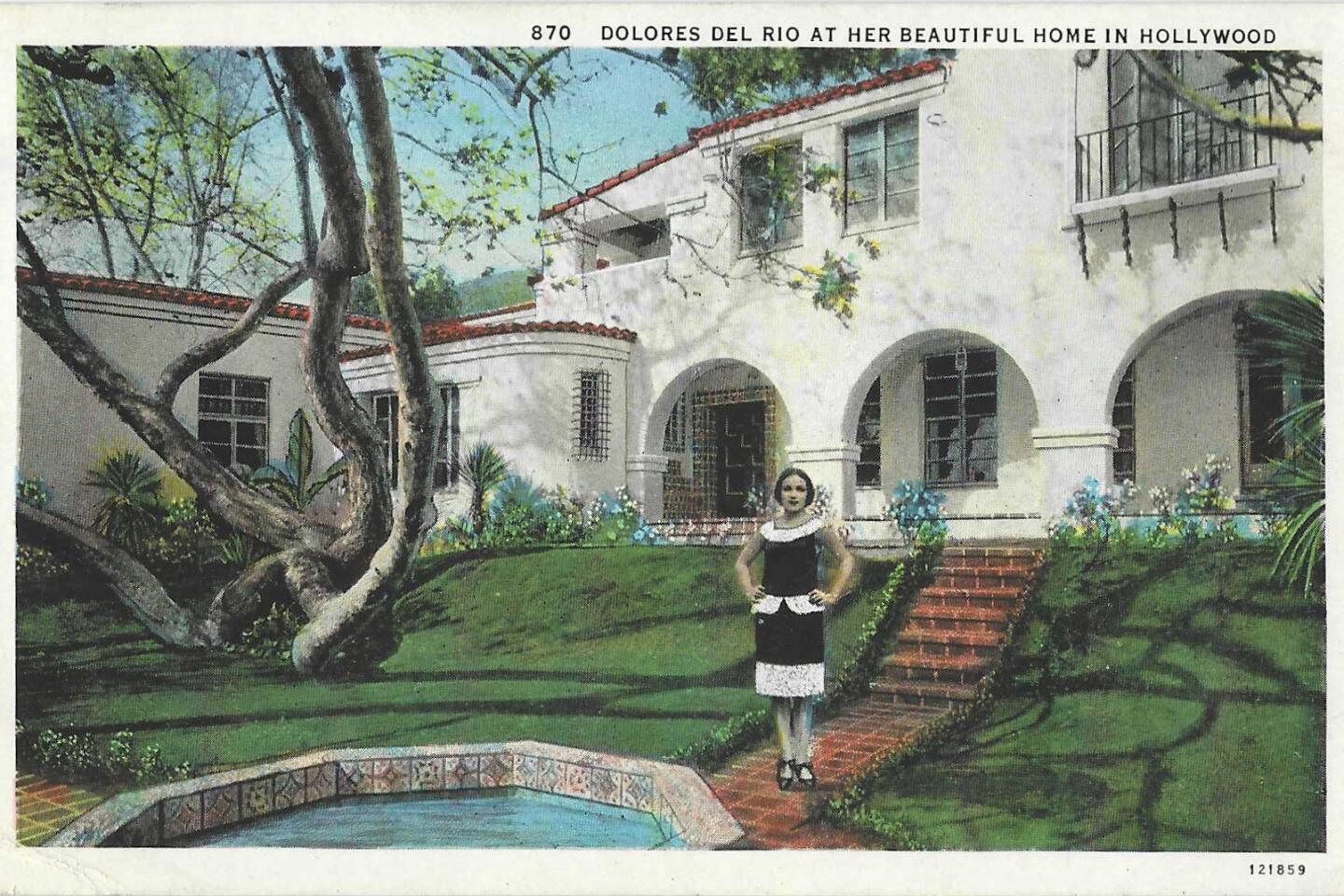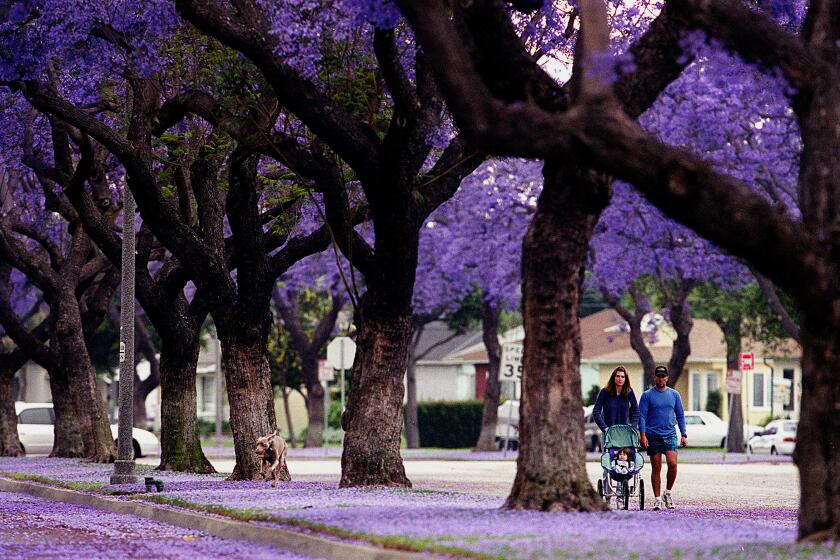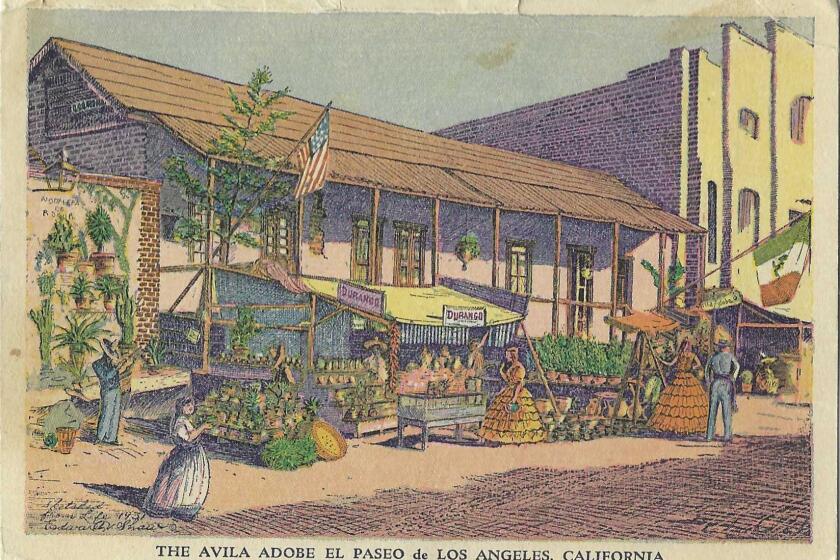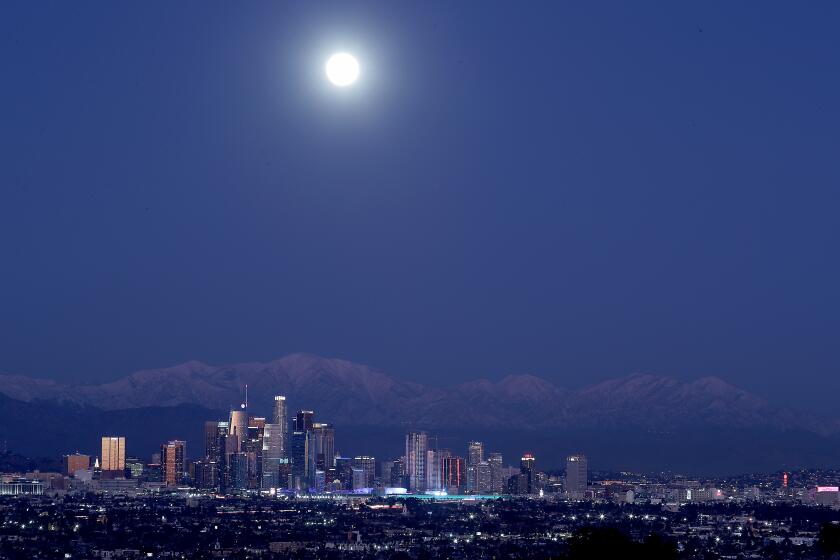The Pacific Ocean is right there. So why is Southern California so hot for swimming pools?
- Share via
Here we are, living 25 miles, five miles, even a scant hundred feet from that splendid dunk known as the Pacific Ocean, and what are we known for the world over?
Swimming pools.
By one calculation from five years ago, there are a quarter-million private swimming pools in Los Angeles County. From the window seat of a 737, they look like flickering blue opals embedded in a matrix of dusty greenery and concrete.
Our stories wouldn’t be our stories without swimming pools as image and metaphor. In “The Graduate,” Benjamin Braddock bastes in his parents’ pool in Pasadena, worrying about his future. Joe Gillis, screenwriter and kept man, floats face down and eyes open in the pool of a mock hacienda in “Sunset Boulevard.” “The poor dope, he always wanted a pool,” Gillis narrates from beyond. “Well, in the end he got himself a pool. Only the price turned out to be a little high” — two bullets in the back, one in the belly. The crowded, chlorinated deep-end water in “Boogie Nights” memorializes porn, pools, and the 1970s San Fernando Valley, the suburban birthplace of a pool paradise as close as your back door.
The celebrated British painter David Hockney turned the swimming pool at the Hollywood Roosevelt hotel into a law unto itself.
The sheer plenty of L.A. pools had enthralled Hockney ever since from his first flight here out of a dreary, late 1963 English winter. He remarked years later: “As I flew over San Bernardino and saw the swimming pools and the houses and everything and the sun, I was more thrilled than I have ever been in arriving in any city.”
Explaining L.A. With Patt Morrison
Los Angeles is a complex place. In this weekly feature, Patt Morrison is explaining how it works, its history and its culture.
He rendered them on canvas after canvas, and then he painted a pool itself. In early 1988, the swimming pool at the Hollywood Roosevelt hotel was emptied. Hockney showed up with cans of paint and a long-handled broom-brush, and all over the pool bottom, he painted what he had already painted on his own swimming pool: scores of parentheses that seemed to move like tadpoles when the pool was filled.
The hotel loved it. The art world loved it. The bureaucrats did not; by law, the bottom of a public pool had to be uniformly, drearily, monochrome.
And here is where the potent iconography of the swimming pool ensorcelled even Sacramento: One law was passed specifically to spare the Hockney Roosevelt pool from that other law commanding that it be painted over.
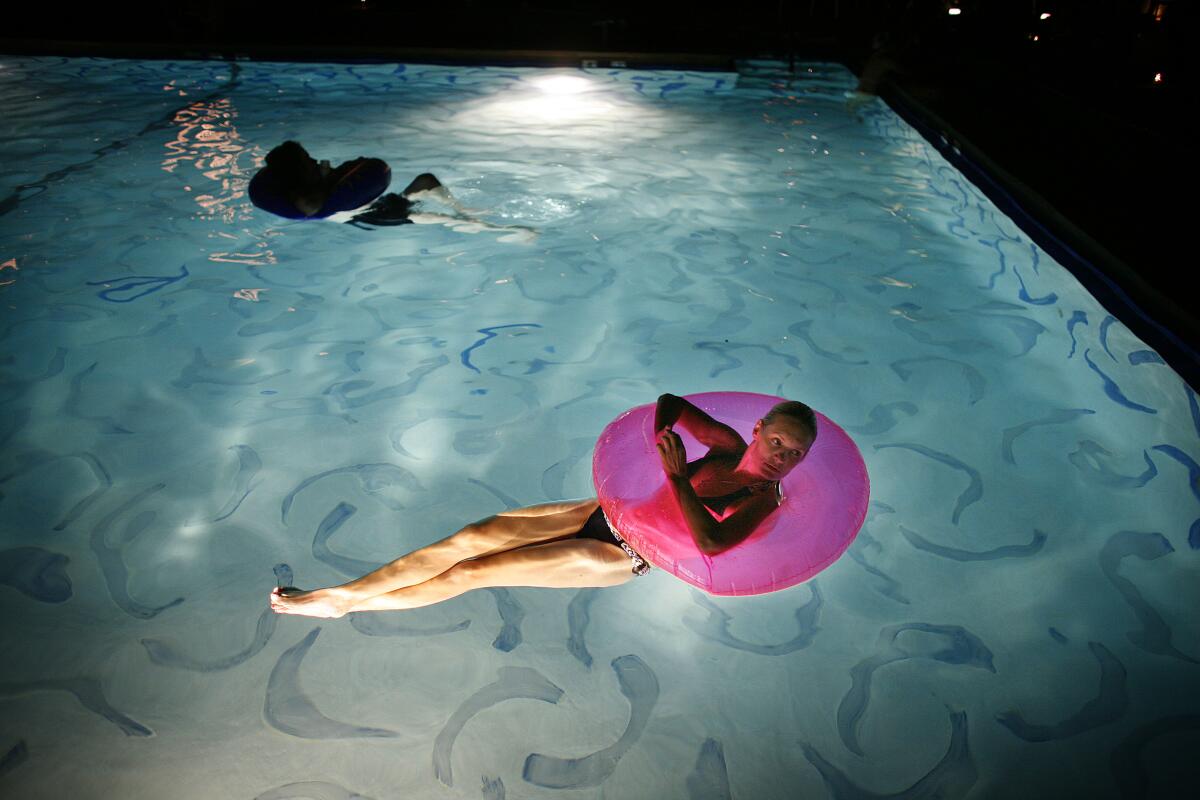
And then, in 2012, in Rialto, a city in that same San Bernardino landscape that had so captivated Hockney, Rodney King, the Black man whose beating at the hands of the LAPD made videotapes of police violence a tool of civil rights and social justice, drowned in his own cherished backyard pool.
The history
The earworm jingle that opens “The Beverly Hillbillies” TV show gets it only half-right, because here, “swimming pools” got decoupled from “movie stars” many decades ago.
The flowering of the Southern California lifestyle, especially after World War II, made the swimming pool the ornament of the Good Life, not the Unreachable Life. As with a convertible or a college education, your regular Joe could now afford pool.
Decades before all that happened — before the technology allowed that to happen — the earliest reference to a Los Angeles private pool I could find in The Times was in January 1914. It listed one at a “pretentious mansion” of 35 rooms — 12 of them bathrooms — being built in Beverly Hills, on a property with a three-mile frontage.
Then, after World War I, when movie fans believed stars walked on water, it was altogether fitting that they had their own private water to do it. From the 1920s, the newspapers let us marvel at them. At Pickfair, the golden couple of silent films, Mary Pickford and Douglas Fairbanks, reigned over a kingdom in miniature whose pool was big enough for a little canoe cruise.
You can determine L.A.’s seasons by our plant life. For example, right now, it’s jacaranda-blooms-stuck-to-your-windshield season. And to understand the Southern California landscape you see, you have to realize that, like you, it is probably not from around here.
The star-smitten 1924 headline “They Swim in Their Own Backyards” reads like an early, prim version of today’s Sunday supplement real estate porn. In 1940, we learned that Sir Cedric Hardwicke’s Sunday afternoon pool parties were quite the thing in Beverly Hills. And that B-pictures actress Constance Moore celebrated her new pool by asking her guests to plant their handprints into the wet cement edging it. That was the nearest that Moore would get to the immortality of the forecourt of Grauman’s Chinese Theater.
The great dive forward into private pools required a joyous confluence of opportunities: cheap mortgages from the GI bill, cheap land in L.A.’s suburbs, especially the San Fernando Valley, and ever-cheaper pool technology that in time would create a prefab molded pool to drop right into a quickly dug backyard excavation. The one-piece pool, like Marilyn Monroe’s one-piece swimsuit, confirmed L.A. as an Everyman’s Eden.
Two years before the war’s end, Sunset, the how-to guide for this new lifestyle, changed its theme to “the magazine of western living,” and offered garden plans crafted around swimming pools.
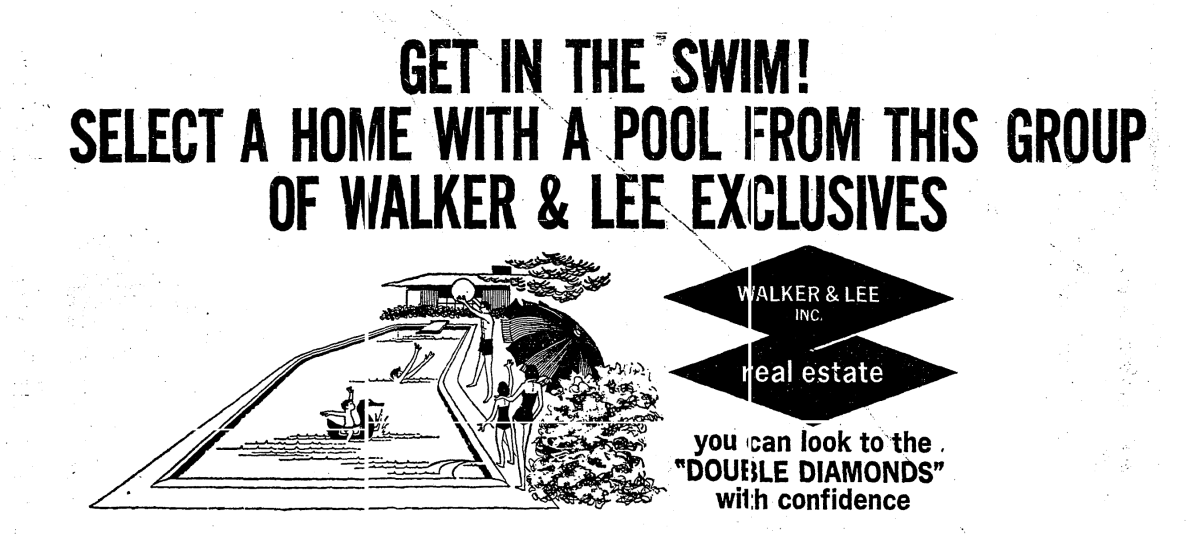
Within a week of the war’s end, in August 1945, as Kevin Roderick notes in his book “The San Fernando Valley,” the Fleetwood pool company was finishing its first custom pool. Anthony Pools could spray concrete onto steel mesh and voila, your quick, thrifty dip. The Anthony firm named its models like subdivisions: the Pasadenan, the Balboa, and the Kidney, an organic shape first crafted by a Finnish designer to make a swimming pool look more like a pond and less like a blue sheet cake.
Technology and budget permitting, you could install an infinity pool, a rock-garden pool, a pool with a spa, a pool with a swim-up bar, even a modest version of the grotto pool at the Playboy mansion, all with “ez payment” plans, and all in time for summer, because here it was perpetually frolicsome summer. The end.
That’s one way to tell the pool story. Here’s the other.
Recreational water was in practice almost always for white people — nominally public beaches, nominally public pools.
It follows that those private swimming pools that were a family’s playground were also, on a regional scale, unintentionally a retreat from a need for civically shared public space.
Los Angeles was conceived as a horizontal city, open to sun and air, and when the three-bedroom, two-bath ideal turned your garden into your personal park, it also muted the demand and support for public places and public parks that often, and chiefly, benefited the poor, the apartment dwellers, the people of color.
We reap the consequences to this day. L.A. is the park-poorest big city in the country. San Francisco, Cincinnati and Austin do better than we do. A 2019 analysis by a housing and construction data outfit called Metrostudy concluded that in spite of its endless summer, L.A. has fewer public pools per capita than places like Omaha, Cleveland, Denver, New Orleans and Pittsburgh.
The “public” in public swimming pools was too often a name, not a policy, and while — as my late colleague George Ramos remembered — Latinos as well as Asians often found themselves shut out, the practices most blatantly barred Black Angelenos.
Around 1925, L.A. officially segregated its swimming pools. It opened — the more genteel world was “reserved” — its pools for Black swimmers only and exclusively on the one day that the pools would be drained and then refilled for white swimmers the rest of the week. Black people sued; a judge ruled that “reserved” met separate-but-equal requirements, case dismissed.
Then, a couple of years later, the city opened a public pool in a Black neighborhood on Central Avenue, figuring that would put an end to complaints. Instead, many Black people boycotted the pool, and a civil rights lawyer named Betty Hill went into overdrive.
In what The Times then described as “trouble which has been fomenting for some months,” Hill enlisted a Black woman named Ethel Prioleau for a Rosa Parks-style action: Prioleau sent her kids to the nearest swimming pool on a whites-only day. The kids were sent home, and Hill went to court.
If you think you’ve heard Prioleau’s name recently, you have. She and her husband were among the owners of the Bruce’s Beach property in Manhattan Beach, land from which the Black owners were forced off and ripped off. Only this year, nearly a hundred years later, did official California pledge to return the land to its original owners.
It took some years, as these things do, and in the meantime, Prioleau had lost her beach land, but she and Hill won their swimming pool case. In June 1931, a judge told the city to integrate its pools, and the City Council chose not to appeal.
“Them: Covenant” on Amazon Prime is a reminder of the all-too-common housing covenants that restricted who could buy homes in certain neighborhoods in Compton, around Southern California and elsewhere. Determined Black people over the decades fought for their rights to live where they pleased.
Pasadena refused to integrate its pools until 1947, the year that a Pasadena man named Jackie Robinson broke through Major League Baseball’s race barricades. The Brookside Plunge opened in 1914, and from the beginning, the pool had a whites-only policy except on Wednesdays — pool-cleaning day.
After Black activists protested, Pasadena declared the public pool was now for whites only, all the time. In 1929, Pasadena — maybe looking warily down the Arroyo Seco to Los Angeles and the Prioleau lawsuit — grudgingly instituted the obliquely named “International Day,” when non-whites could swim one afternoon a week.
But then, six Black men got the boot after showing up to swim on a whites-only day. And the NAACP took Pasadena to court and won. This time, Pasadena shut down the pool entirely, rather than open it to people of color.
In Robinson’s memory, Pasadena was a place where Black people “saw movies from segregated balconies, swam in a municipal pool only on Tuesdays and were permitted in the YMCA one night a week. … In certain respects, people in Pasadena were less understanding than Southerners, and even more hostile.”
Finally, on July 7, 1947, two years after the NAACP won its case and almost three months after Robinson set foot onto Ebbets Field in a Brooklyn Dodgers uniform, Robinson’s hometown swimming pool opened its waters to all people, all the time.
One of the California kids who used the pool on “international day” was Sammy Lee. One day a week wasn’t enough to train to be the diver he wanted to be, so he practiced on a homemade diving board over a sand pit his coach dug in his backyard. And after World War II, he became the first Asian American man to earn gold medals, and he did it in diving events in two Olympic games.
Policy is not the same as practice. In August of 1968, the city approved plans for a pool and bathhouse in Granada Hills — a white Valley neighborhood with pools aplenty. Yet as The Times noted then, another Valley neighborhood, Pacoima, then “heavily Negro,” had only a wading pool. “A cool place to swim for children trapped in a hot poverty pocket,” The Times concluded, “seems at least as important” as one for Granada Hills.
Native American settlements were first, and then the rancho system -- Spanish then Mexican land grants throughout California -- were built atop and near those settlements and still shape our geography and place names.
The future of pools
And so we come to now, the age of acknowledged drought, and the ethics of water for ornament or recreation. The pool trade likes the bullet point that a backyard pool requires no more water than does a lawn. But nowadays, keeping up a rich, dense lawn is itself looking like an act of reckless profligacy.
Nearly 20 years ago, the Metropolitan Water District found that an average-sized uncovered swimming pool loses about 20,000 gallons a year to evaporation. In 2015, after Gov. Jerry Brown’s order that the state use 25% less water to brace for drought, cities like Santa Cruz banned the filling of pools entirely. Pool demolition became a growth industry.
My hero, Paul Chen of Cerritos, tore out the blue hole that for 25 years had been his backyard pool. That was in 2015. The drought, he explained, was “my main concern. You have to keep replenishing the water. Of course we can afford it, but you feel it’s unfair. ... And you definitely feel a little guilty.” Well said, sir. Just because you can afford it doesn’t mean we can afford it.
L.A. is a creation of our own mythologies. One, maybe the biggest one, was that water was practically infinite and practically free. Now that we know better, what new L.A. do we create for ourselves? How do we get there? And can we still do it by doing the backstroke in our own backyards?
L.A. is a place like no other. You’ve got questions. Patt Morrison probably has answers and can definitely find out.
More to Read
Sign up for Essential California
The most important California stories and recommendations in your inbox every morning.
You may occasionally receive promotional content from the Los Angeles Times.
